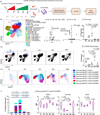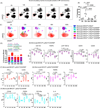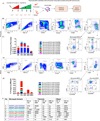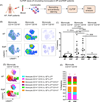Novel Circulating and Tissue Monocytes as Well as Macrophages in Pancreatitis and Recovery
- PMID: 34450180
- PMCID: PMC8796698
- DOI: 10.1053/j.gastro.2021.08.033
Novel Circulating and Tissue Monocytes as Well as Macrophages in Pancreatitis and Recovery
Abstract
Background and aims: Acute pancreatitis (AP) is an inflammatory disease with mild to severe course that is associated with local and systemic complications and significant mortality. Uncovering inflammatory pathways that lead to progression and recovery will inform ways to monitor and/or develop effective therapies.
Methods: We performed single-cell mass Cytometry by Time Of Flight (CyTOF) analysis to identify pancreatic and systemic inflammatory signals during mild AP (referred to as AP), severe AP (SAP), and recovery using 2 independent experimental models and blood from patients with AP and recurrent AP. Flow cytometric validation of monocytes subsets identified using CyTOF analysis was performed independently.
Results: Ly6C+ inflammatory monocytes were the most altered cells in the pancreas during experimental AP, recovery, and SAP. Deep profiling uncovered heterogeneity among pancreatic and blood monocytes and identified 7 novel subsets during AP and recovery, and 6 monocyte subsets during SAP. Notably, a dynamic shift in pancreatic CD206+ macrophage population was observed during AP and recovery. Deeper profiling of the CD206+ macrophage identified 7 novel subsets during AP, recovery, and SAP. Differential expression analysis of these novel monocyte and CD206+ macrophage subsets revealed significantly altered surface (CD44, CD54, CD115, CD140a, CD196, podoplanin) and functional markers (interferon-γ, interleukin 4, interleukin 22, latency associated peptide-transforming growth factor-β, tumor necrosis factor-α, T-bet, RoRγt) that were associated with recovery and SAP. Moreover, a targeted functional analysis further revealed distinct expression of pro- and anti-inflammatory cytokines by pancreatic CD206+ macrophage subsets as the disease either progressed or resolved. Similarly, we identified heterogeneity among circulating classical inflammatory monocytes (CD14+CD16-) and novel subsets in patients with AP and recurrent AP.
Conclusions: We identified several novel monocyte/macrophage subsets with unique phenotype and functional characteristics that are associated with AP, recovery, and SAP. Our findings highlight differential innate immune responses during AP progression and recovery that can be leveraged for future disease monitoring and targeting.
Keywords: Acute Pancreatitis; CyTOF; Macrophages; Monocytes; Severe Acute Pancreatitis.
Copyright © 2021 AGA Institute. Published by Elsevier Inc. All rights reserved.
Conflict of interest statement
Declaration of Interest
The authors declare no competing interests.
Figures







Comment in
-
Novel Insights Into Macrophage Diversity During the Course of Pancreatitis.Gastroenterology. 2021 Dec;161(6):1802-1805. doi: 10.1053/j.gastro.2021.09.049. Epub 2021 Sep 26. Gastroenterology. 2021. PMID: 34587487 No abstract available.
References
-
- Zhang R, Shi J, Zhang R, et al. Expanded CD14(hi)CD16(−) Immunosuppressive Monocytes Predict Disease Severity in Patients with Acute Pancreatitis. J Immunol. 2019;202(9):2578–2584. - PubMed
Publication types
MeSH terms
Substances
Grants and funding
LinkOut - more resources
Full Text Sources
Medical
Research Materials
Miscellaneous

